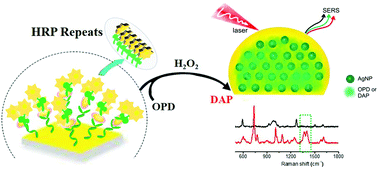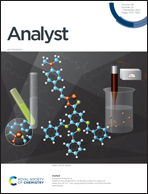Horseradish peroxidase-repeat assay based on tyramine signal amplification for highly sensitive H2O2 detection by surface-enhanced Raman scattering†
Abstract
A new and simple surface-enhanced Raman scattering (SERS) biosensor based on the tyramine signal amplification (TSA)-triggered formation of horseradish peroxidase (HRP) repeats on a gold sensing chip was designed for the highly sensitive detection of hydrogen peroxide (H2O2). Initially, gold wafers were functionalized with HRP as sensing chips. Then, the HRP immobilized on the chips triggers the TSA reaction to transform the tyramine–HRP conjugate into a tyramine–HRP repeat array. With the aid of the target H2O2, the HRP repeats catalyze the oxidation of o-phenylenediamine (OPD) and produce an enzyme catalytic product with a different chemical structure, thus altering the fingerprint of the SERS spectra from that of OPD. H2O2 can be quantitatively analyzed according to the change in SERS signal intensity. On the basis of the TSA strategy, the proposed method allows the detection of H2O2 with a limit of detection (LOD) of 0.8 × 10−8 M. The as-prepared SERS sensor can achieve high-sensitivity H2O2 detection with a small amount of sample for each analysis. Therefore, this sensor exhibits significant potential for application in bioanalysis.



 Please wait while we load your content...
Please wait while we load your content...